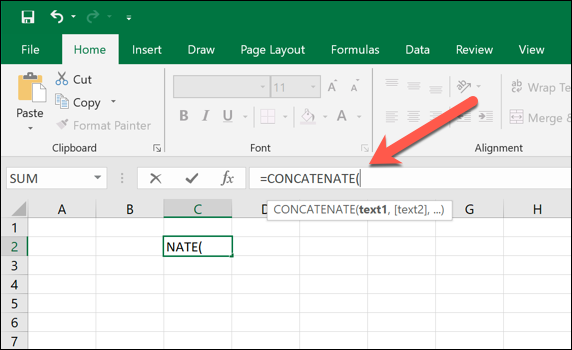
Excel is an indispensable tool for data management and analysis, offering a wide array of functions to streamline and enhance your work. Among these, the CONCATENATE function is one of the most useful for combining text strings from different cells. Whether you are a beginner or an advanced user, mastering CONCATENATE can significantly improve your productivity and data manipulation skills. This comprehensive guide will cover everything you need to know about using the CONCATENATE function in Excel, from basic usage to advanced techniques and practical applications.
Table of Contents
- Introduction
- Benefits of Using the CONCATENATE Function
- Basic Syntax and Usage
- CONCATENATE Function
- CONCAT Function
- Ampersand (&) Operator
- Practical Examples
- Combining First and Last Names
- Creating Full Addresses
- Merging Dates and Times
- Advanced Techniques
- Combining Text with Numbers
- Using CONCATENATE with Other Functions
- Handling Blank Cells
- Adding Delimiters
- Tips and Tricks
- Using Text Functions for Better Results
- Automating Text Concatenation with VBA
- Common Errors and Troubleshooting
- #VALUE! Error
- Issues with Cell References
- Best Practices
- Keeping Formulas Simple
- Documenting Your Work
- Real-World Applications
- Data Cleaning and Preparation
- Report Generation
- Dashboard Creation
- Conclusion
1. Introduction
The CONCATENATE function in Excel is designed to join two or more text strings into one string. This is particularly useful in various data manipulation tasks, such as combining names, creating full addresses, or merging different pieces of information into a single cell. Understanding how to use the CONCATENATE function effectively can save you time and effort, making your data management processes more efficient.
2. Benefits of Using the CONCATENATE Function
- Data Combination: Easily combine text from multiple cells into one.
- Automation: Automate repetitive text joining tasks.
- Consistency: Ensure consistent formatting across your dataset.
- Efficiency: Save time by using formulas instead of manual entry.
3. Basic Syntax and Usage
CONCATENATE Function
The basic syntax of the CONCATENATE function is straightforward:
=CONCATENATE(text1, text2, [text3], ...)
- text1, text2, [text3], …: These are the text strings you want to combine. You can input text directly, or reference cells containing text.
CONCAT Function
In Excel 2016 and later versions, the CONCAT function is introduced as an improvement over CONCATENATE. The syntax is similar but offers more flexibility:
=CONCAT(text1, [text2], ...)
Ampersand (&) Operator
You can also use the ampersand (&) operator to concatenate text. This is often simpler and more intuitive:
=A1 & B1
or
="Hello, " & "world!"
4. Practical Examples
Combining First and Last Names
Suppose you have a list of first names in column A and last names in column B. To combine them into full names in column C:
=CONCATENATE(A2, " ", B2)
or using the & operator:
=A2 & " " & B2
Creating Full Addresses
To create a full address from street, city, and state columns:
=CONCATENATE(A2, ", ", B2, ", ", C2)
or using the & operator:
=A2 & ", " & B2 & ", " & C2
Merging Dates and Times
If you have a date in cell A2 and a time in cell B2, you can combine them:
=CONCATENATE(TEXT(A2, "mm/dd/yyyy"), " ", TEXT(B2, "hh:mm AM/PM"))
5. Advanced Techniques
Combining Text with Numbers
When combining text with numbers, you might need to format the numbers:
=CONCATENATE("Total: $", TEXT(A2, "0.00"))
Using CONCATENATE with Other Functions
You can combine CONCATENATE with other functions for more complex tasks. For example, combining IF function:
=CONCATENATE("Status: ", IF(A2>10, "High", "Low"))
Handling Blank Cells
To avoid issues with blank cells, you can use the IF function to check for blanks:
=IF(A2="", "", CONCATENATE(A2, " ", B2))
Adding Delimiters
When combining text, you often need delimiters like commas or spaces:
=CONCATENATE(A2, ", ", B2, ", ", C2)
or
=A2 & ", " & B2 & ", " & C2
6. Tips and Tricks
Using Text Functions for Better Results
Functions like TEXT, LEFT, RIGHT, MID, and TRIM can be used alongside CONCATENATE for better results.
Automating Text Concatenation with VBA
For repetitive tasks, you can use VBA to automate text concatenation. A simple VBA example:
Sub ConcatenateCells()
Dim rng As Range
Dim cell As Range
Dim result As String
Set rng = Range("A1:A10")
For Each cell In rng
result = result & cell.Value & " "
Next cell
Range("B1").Value = result
End Sub
7. Common Errors and Troubleshooting
#VALUE! Error
This error typically occurs if one of the CONCATENATE arguments is invalid. Ensure all referenced cells contain text or are properly formatted.
Issues with Cell References
Ensure that cell references are correct and cells are not merged or hidden.
8. Best Practices
Keeping Formulas Simple
Break down complex concatenation tasks into smaller, simpler formulas where possible.
Documenting Your Work
Use comments or notes to document your formulas and the purpose they serve.
9. Real-World Applications
Data Cleaning and Preparation
Use CONCATENATE to clean and prepare data for analysis by combining necessary fields into single columns.
Report Generation
Generate dynamic reports by combining various data points into comprehensive text fields.
Dashboard Creation
Use CONCATENATE to create labels and text elements dynamically in dashboards.
10. Conclusion
The CONCATENATE function, along with its modern counterpart CONCAT and the ampersand (&) operator, provides powerful tools for combining text in Excel. By mastering these functions, you can streamline your data management tasks, enhance your reports, and increase your overall efficiency in Excel. Whether you are preparing data for analysis, creating comprehensive reports, or designing dynamic dashboards, understanding and effectively using text concatenation is an invaluable skill in Excel.
Remember to explore advanced techniques, incorporate other Excel functions, and follow best practices to get the most out of the CONCATENATE function. With practice and experience, you’ll find countless ways to leverage this capability in your daily work.